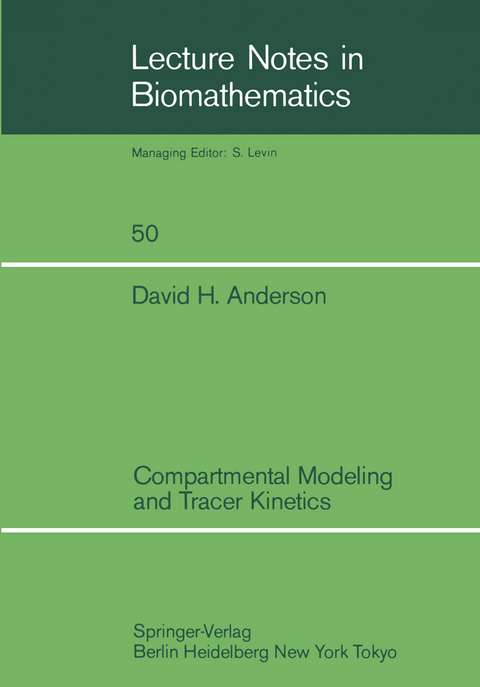
Compartmental Modeling and Tracer Kinetics
Springer Berlin (Verlag)
978-3-540-12303-3 (ISBN)
Section 1. Compartmental Systems.- 1A. Introduction.- 1B. Preliminary definitions.- 1C. Tracer experiments.- 1D. History of compartmental analysis.- Section 2. Elementary Compartmental Models.- 2A. Drug kinetics.- 2B. Leaky fluid tanks.- 2C. Diffusion.- 2D. Solute mixture.- Section 3. First-Order Chemical Reactions.- Section 4. Environmental Studies.- 4A. Kinetics of lead in the body.- 4B. The Aleut ecosystem.- Section 5. Nonlinear Compartmental Models.- 5A. Continuous flow chemical reactor.- 5B. Reaction order.- 5C. Other nonlinear compartmental models.- Section 6. The General Compartmental Model.- Section 7. Tracer Kinetics in Steady-State Systems.- 7A. The tracer equations.- 7B. Linear compartmental models..- Section 8. Uptake of Potassium by Red Blood Cells.- Section 9. Standard Types of Tracer Experiments.- 9A. Tracer concentration equations.- 9B. Tracer specific activity equations.- Section 10. Analytical Solution of the Tracer Model.- 10A. The general solution of the model.- 10B. Nonnegativity of the solution.- Section 11. System Structure and Connectivity.- 11A. The connectivity diagram.- 11B. Common compartmental systems.- 11C. Strongly connected systems.- Section 12. System Eigenvalues and Stability..- 12A. Nonpositive eigenvalues ..- 12B. The smallest magnitude eigenvalue.- 12C. Symmetrizable compartmental matrices and real eigenvalues.- 12D. Distinct eigenvalues.- 12E. Compartmental model stability.- 12F. Bounds on the extreme eigenvalues.- Section 13. The Inverse of a Compartmental Matrix.- 13A. Invertibility conditions.- 13B. A Neumann series for the inverse matrix.- 13C. Matrix inequalities.- Section 14. Mean Times and the Inverse Matrix.- 14A. Mean residence times.- 14B. The compartmental matrix exponential.- 14C. Further properties of mean residence time.- 14D. System Mean residence time.- Section 15. Solution of the Steady-State Problem for SEC Systems.- 15A. The tracer steady-state problem.- 15B. Ill-conditioned SEC systems.- 15C. An iterative procedure for SEC systems.- 15D. Updating the algorithm.- Section 16. Structural Identification of the Model.- 16A. The system (A, B, C).- 16B. The structural identification problem.- 16C. A simple identification example.- 16D. Realizations of impulse response functions.- 16E. Impulse response function structure.- 16F. Nonlinear identification equations.- 16G. A three compartment model.- 16H. A four compartment model.- Section 17. Necessary and Sufficient Conditions for Identifiability.- 17A. Model identifiability.- 17B. Necessary conditions.- 17C. Sufficient conditions.- Section 18. A Simple Test for Nonidentifiability.- 18A. Counting nonzero transfer function coefficients.- 18B. Coefficient structure.- 18C. Further refinements of formula (18.4).- 18D. The nonidentifiability test.- 18E. Tighter bounds on the number of independent equations.- Section 19. Computation of the Model Parameters.- 19A. Local identifiability.- 19B. Newton's method and modifications.- 19C. The Kantorovich conditions.- 19D. An example.- Section 20. An Alternative Approach to Identification.- 20A. A new identification method.- 20B. The component matrices of A.- 20C. The identification technique using component matrices.- 20D. Identification of a lipoprotein model.- 20E. The identification technique using modal matrices.- 20F. Identification of a pharmacokinetic system.- 20G. Spectral sensitivity of a linear model.- Section 21. Controllability, Observability, and Parameter Identifiability.- 21A. The control problem.- 21B. Completely controllable systems.- 21C. Completely observable systems.- 21D.Realizations and identifiability.- 21E. A third method of identifiability.- Section 22. Model Identification from the Transfer Function Equations.- 22A. Form of the nonlinear equations.- 22B. Coefficients of the transfer fuction.- 22C. The nonlinear algebraic equations for the identification problem.- 22D. Necessary conditions for positive solutions of the nonlinear system.- 22E. Refined necessary conditions.- 22F. Additional properties of the nonlinear algebraic system.- 22G. An iterative scheme for solving F(?) = 0.- 22H. Triangularization of F(?) = 0.- 22I. Uniqueness of solution F(?) = 0.- Section 23. The Parameter Estimation Problem.- 23A. The basic estimation problem.- 23B. A lipoprotein metabolism model.- 23C. Nonlinear least-squares.- 23D. Initial parameter estimates.- 23E. Method of moments.- 23F. Other methods of parameter estimation.- 23G. Positive amplitudes.- 23H. Curve-fitting sums of exponentials is ill-posed.- 23I. Fitting the differential equation model directly to data.- 23J. Modulating function method.- 23K. An antigen - antibody reaction example.- 23L. Additional literature on fitting of differential equations to data.- Section 24. Numerical Simulation of the Model.- 24A. Compartmental model simulation.- 24B. A three compartment thyroxine model.- 24C. Numerical integration methods and some inadequacies.- 24D. Implicit methods ..- 24E. Determining model stiffness.- Section 25. Identification of Compartment Volumes.- 25A. The basic single exit compartmental model.- 25B. Readily identifiable parameters.- 25C. The catenary single exit system.- 25D. Estimation of compartmental volumes.- 25E. Creatinine clearance model.- 25F. Shock therapy.- 25G. Bounds and approximations on compartmental volumes.- Section 26. A Discrete Time Stochastic Model of aCompartmental System.- 26A. The Markov chain model.- 26B. The liver disease model.- 26C. Simulation of the hepatic system.- 26D. Mathematical analysis of the model.- 26E. Parameter estimation.- 26F. Discussion.- Section 27. Closing Remarks.
| Erscheint lt. Verlag | 1.7.1983 |
|---|---|
| Reihe/Serie | Lecture Notes in Biomathematics |
| Zusatzinfo | IX, 304 p. |
| Verlagsort | Berlin |
| Sprache | englisch |
| Maße | 170 x 244 mm |
| Gewicht | 547 g |
| Themenwelt | Mathematik / Informatik ► Mathematik |
| Studium ► Querschnittsbereiche ► Epidemiologie / Med. Biometrie | |
| Naturwissenschaften ► Biologie | |
| Schlagworte | Algebra • Biologisch-mathematisches Modell • Fitting • Kinetics • Markov Chain • Metabolism • Modeling • Observable • Tracer-Methode |
| ISBN-10 | 3-540-12303-2 / 3540123032 |
| ISBN-13 | 978-3-540-12303-3 / 9783540123033 |
| Zustand | Neuware |
| Haben Sie eine Frage zum Produkt? |
aus dem Bereich


